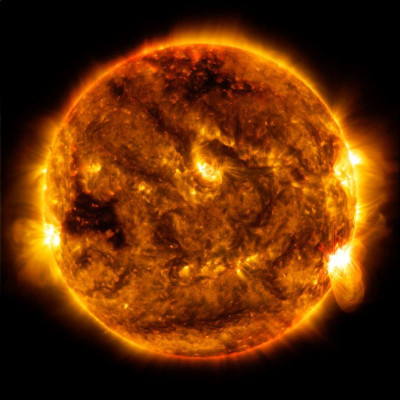NERSC’s Cori System Helps Shed New Light on Plasma Turbulence
November 10, 2022
By Patrick Riley
Contact: cscomms@lbl.gov

Propelled by the computing power at the National Energy Research Scientific Computing Center (NERSC) at Lawrence Berkeley National Laboratory (Berkeley Lab), Columbia University scientists used supercomputers to show when and how high-energy particles are formed in turbulent environments like the sun’s atmosphere.
With the help of NERSC’s Cori system and supercomputers at Columbia and NASA, astrophysicists Luca Comisso and Lorenzo Sironi of Columbia’s Department of Astronomy and the Astrophysics Laboratory ran large-scale simulations that show the precise movements of electrons and ions in the sun’s plasma.
The new research, presented in a paper titled “Ion and Electron Acceleration in Fully Kinetic Plasma Turbulence” that was recently published in The Astrophysical Journal Letters, helps pave the way to improve forecasting models of space weather events and better predict the origin of solar energetic particles.
High-energy particles pelt the earth and objects outside the earth’s atmosphere with radiation at unpredictable times, and the study is one piece of the puzzle in eventually figuring out when dangerous bursts of these particles will occur.
Given the scale of the simulations, the groundbreaking research would not have been possible without Cori’s computing capabilities and memory capacity, said Comisso, who has had previous experience with the NERSC system.
“Cori was great, in terms of, it gave me the memory that I needed” for my simulations, he said. “So for this reason, it was a good fit for what I needed to do.”
Nonthermal energetic particles are abundant in space and astrophysical environments – from the solar corona and wind to supernova remnants and jets from supermassive black holes – but “their origin is still poorly understood,” the scientists write in their paper. Turbulence in collisionless plasmas is often looked at as a potential process responsible for the particles’ acceleration.
But whereas in the past researchers had to rely on different approximations leading to different conclusions to study the topic, the Columbia scientists were the first ones to try to solve the problem of particle acceleration in a classical turbulent plasma in a fully kinetic way using supercomputers, Comisso said.
“What we have is the most accurate, let’s say, description of what should occur…,” he said. “It’s the most accurate because we use the most accurate method.”
For their paper, the researchers conducted four very large simulations, called hero simulations, – two on Cori and two on NASA’s Pleiades system. All told, the project took more than 50 million CPU hours, Comisso said. The code they used is called TRISTAN-MP, which is mostly applied to astrophysics.
Even before the very large simulations, the researchers put pen to paper to find the right parameters to study and ran scores of smaller, preliminary simulations – about 100 – with some in 2D and some in 3D.
In the end, the scientists had “few surprises” when they ran the largest simulations, Comisso said, “because we experimented so much that we had already a very good clue of what had to happen.”
It was exciting to make the problem fit the computer, he added, because even with Cori’s robust computational power, the magnitude of the problem makes for a challenge.
“Cori is a crazy good machine, but still, reality is more complex,” he said.
Comisso likened it to studying how a large tree behaves by looking at a bonsai first. “We are not at the stage where we can simulate the entire tree,” he said. But the bonsai is small enough and follows similar or the same rules as a larger tree: it still needs sunlight and water. By capturing what’s going on with the bonsai, the scientists can use physics to extrapolate what would happen if the bonsai were taller.
The same goes for how turbulence in a plasma can accelerate constituent particles and what their distribution looks like – meaning how many particles we should expect in any given energy range.
The problem is so large and complex that even for powerful supercomputers it has to be downsized to be able to process it. So while the scientists may have only been able to look at the bonsai through their simulations, it gives them an idea of how the full-size tree behaves in reality.
In the future, Comisso said, scientists will potentially be able to simulate the real system. But that will take time.
“I think it will take many, many decades to add the full system because even if it is true that computers are evolving quickly … we are still orders of magnitude below the real size that we want to simulate,” he said.
This story utilizes information from a Columbia University news release.
About NERSC and Berkeley Lab
The National Energy Research Scientific Computing Center (NERSC) is a U.S. Department of Energy Office of Science User Facility that serves as the primary high performance computing center for scientific research sponsored by the Office of Science. Located at Lawrence Berkeley National Laboratory, NERSC serves almost 10,000 scientists at national laboratories and universities researching a wide range of problems in climate, fusion energy, materials science, physics, chemistry, computational biology, and other disciplines. Berkeley Lab is a DOE national laboratory located in Berkeley, California. It conducts unclassified scientific research and is managed by the University of California for the U.S. Department of Energy. »Learn more about computing sciences at Berkeley Lab.







